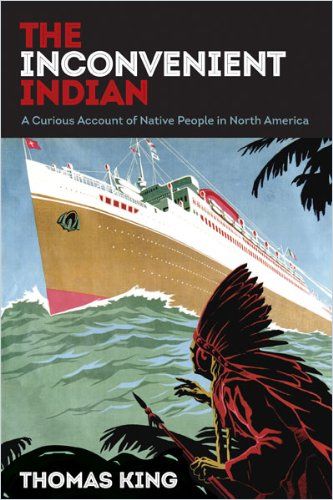Professor Thomas King laments the brutal treatment of Native Americans and First Nations Canadians at the hands of white settlers and governments and offers a shameful history of greed and genocide.

Extermination, Assimilation, Legalized Payback
Professor Thomas King eviscerates the United States and Canadian governments for their genocide of Native peoples. As he covers centuries of atrocities, he illuminates the plight of the millions of Native peoples in North America. King uses the phrase “inconvenient Indian” to describe survivors who have resisted assimilation.
King, who is professor emeritus at the School of English and Theatre Studies at the University of Guelph, offers a heartbreaking, impressionistic analysis. His sharp wit and stylish writing make this a gripping read.
His eye-opening account argues in favor of learning about the historic mistakes of your country and mining that history for relevant messages. Inconvenient Indian attained bestseller status and collected numerous literary accolades, including being named the Canadian Booksellers Association Non-Fiction Book of the Year in 2013. King debunks legends and myths and offers the real story, which is richer, more raw and much harder to accept. His work is appropriate background reading to mark the depth of meaning behind Canada’s Truth & Reconciliation commemorations.
Historical Fictions
According to the legend of John Smith and Pocahontas, when the Powhatan tribe captured Smith in 1607, the maiden Pocahontas saved him from execution. History disproves this myth featuring a Native American’s infatuation with a white man. Smith, a mercenary, notoriously had claimed that damsels spared him from death in Turkey, Russia and France. In 1607, he would have been 27 and Pocahontas 10 or 12. There’s no record that he mentioned Pocahontas until she arrived in England in 1616 on a transatlantic visit. Smith’s self-glorifying fiction traded on the princess’s celebrity.
As with John Smith and Pocahontas, we like the story of Custer’s Last Stand too much to ever give it up. Thomas King
Americans somehow recast the demise of George Armstrong Custer and his troops at the 1876 Battle of Little Bighorn as heroic. The Lakota and Northern Cheyenne tribes commanded by Sitting Bull and Crazy Horse killed all 258 of Custer’s men – a slaughter precipitated by Custer’s widely acknowledged, lethal ineptitude.
White Supremacy
Throughout the 1800s, prominent European thinkers espoused Caucasians’ place atop humanity’s evolutionary ladder. In James Fenimore Cooper’s1841 novel, The Deerslayer, one character ranks the white race first, followed by the others whom he describes as not entirely human. In The Descent of Man in 1871, Charles Darwin similarly argued that Europeans were the superior race, a biased mind-set that endured.
In plays, poems and novels, white writers recast Indians not as subhuman, but as noble savages, with the twist that their race could not survive, and that the heroics of a single indigenous person couldn’t save it.
A White Narrative
Native peoples live in a reverse version of the Samuel Beckett play Waiting for Godot. In that piece, characters wait desperately for a savior to appear, but he never shows up. In the Native version of this story, Godot arrives as the white man and never leaves. As Europeans recast Native American history, they claimed native people were lost souls yearning for democracy, capitalism and Christianity.
North America defends democracy as the cornerstone of social, religious and political enlightenment because it is obliged to think well of itself and its institutions.Thomas King
Europeans tricked and strong-armed Natives. For example, Indiana Gov. William Henry Harrison fabricated a treaty with a group of Sauk chiefs whom Harrison either threatened or got drunk, so they would sign his proposal. The chiefs had no authority to negotiate on behalf of the Sauk tribe, but Harrison pretended they did.
In 1830, President Andrew Jackson signed the Removal Act that legalized the Trail of Tears – the forced march of Native people from their homes to Indian Territory. The US government forcibly relocated dozens of tribes from Georgia, North Carolina and other southern states to the territory of Oklahoma, forcing 100,000 or more Indians onto the Trail of Tears. About 4,000 of 17,000 Cherokee perished during this migration.
Continent-Wide Relocations
Canadian bureaucrats viewed the First Peoples as unfit to make responsible decisions about their own lives. If a tribe appeared to be starving, the government moved the population to places the bureaucrats deemed more convenient.
Moving Indians around the continent was like redecorating a very large house.Thomas King
The United States and Canada both sought to remove “inconvenient” Indians from valuable real estate. Canada’s relocations started in 1836, with the excuse that the government had to shelter Natives from the white race’s vices.
For example, the Canadian government forced the Ojibway people to give up 600,000 hectares in Ontario. The government promised that if they moved, the white man would leave the Ojibway alone. Instead, the government forced them to surrender their territory again and again, each time sending them to increasingly tiny plots of land. Eskasoni First Nation and Shubenacadie tribe members, whom the government moved to reserve land in 1942, were still living in tents years later.
Extermination
In the 1800s, white Americans and Canadians regarded the extermination – by weapons, disease and starvation – of indigenous tribes as the natural order of things. Assimilation meant that rather than kill Indigenous people, whites would absorb their culture in exchange for civilization and salvation.
This was not to be a compromise between cultures. It was to be a unilateral surrender. Thomas King
European invaders never sought coexistence with Native peoples. They demanded that Natives give up their languages, faiths and cultures, and embrace the religions, culture and art of the white man.
Assimilation
In 1879, US Army officer Richard Pratt sought to assimilate Native people by moving Indian children to rough boarding schools far from their families, and forcing them to speak only English, follow Protestant Christianity and learn mainstream vocations. By 1909, two dozen such schools were operating in the United States. Canada also established a network of similar schools.
The Canadian apology, while heartfelt, was, in many ways, a stingy thing, limited only to the abuse that Native people had endured in the residential school system. Thomas King
Many of the schoolmasters starved the children and neglected their health. Tuberculosis spread, and students suffered sexual and physical abuse. Half of the Native students in Alberta’s residential schools died. In British Columbia, the mortality rate was 30%.
Legalized Gambling
In 1988, the US Congress passed the Indian Gaming Regulatory Act, allowing tribal governments to open casinos, but compelling them to share proceeds with state governments. Canada passed a similar act. Now, Native casinos generate $25 billion a year in revenue.
The primary way that Ottawa and Washington deal with Native people is to ignore us.Thomas King
For Native peoples, gambling is a mixed blessing that provides jobs and generates revenue, but creates nothing of value.Legalized gambling made Native Americans and Indigenous Canadians into benefactors for their oppressors. For instance, Arizona’s tribal casinos have contributed more than $400 million to that state’s budget. Connecticut gets $200 million a year from the Mohegan Sun and Foxwoods casinos.
A Litany of Horrors
King builds a familiar tragedy from salient details and little-known, horrible facts. His overview of 500 years of North American history offers scant glad tidings for Native Americans and First Nation Canadians. He offers up the relentlessness, scale and scope of white greed and violence to provide a factual, useful and accessible context for current Native policies in the United States and Canada.
King’s somewhat gee-whiz tone and his gleeful underscoring of quite obvious, fatal ironies weaken both his credibility and the pleasure of reading this necessary, heartbreaking text – a must for high school students in North America and for American and Canadian adults who don’t yet know their nation’s history.
Thomas King also wrote One Good Story, That One; A Short History of Indians in Canada; The Truth About Stories: A Native Narrative; and Medicine River.






